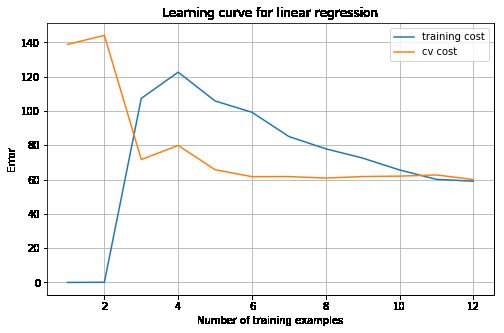吴恩达机器学习作业Python实现(五):偏差和方差
吴恩达机器学习系列作业目录
在本练习中,您将实现正则化的线性回归和多项式回归,并使用它来研究具有不同偏差-方差属性的模型
1 Regularized Linear Regression 正则线性回归
在前半部分的练习中,你将实现正则化线性回归,以预测水库中的水位变化,从而预测大坝流出的水量。在下半部分中,您将通过一些调试学习算法的诊断,并检查偏差 v.s. 方差的影响。
1.1 Visualizing the dataset
我们将从可视化数据集开始,其中包含水位变化的历史记录,x,以及从大坝流出的水量,y。
这个数据集分为了三个部分:
- training set 训练集:训练模型
- cross validation set 交叉验证集:选择正则化参数
- test set 测试集:评估性能,模型训练中不曾用过的样本
%matplotlib inline
import numpy as np
import matplotlib.pyplot as plt
from scipy.io import loadmat
import scipy.optimize as opt
读取数据
path = 'ex5data1.mat'
data = loadmat(path)
#Training set
X, y = data['X'], data['y']
#Cross validation set
Xval, yval = data['Xval'], data['yval']
#Test set
Xtest, ytest = data['Xtest'], data['ytest']
#Insert a column of 1's to all of the X's, as usual
X = np.insert(X ,0,1,axis=1)
Xval = np.insert(Xval ,0,1,axis=1)
Xtest = np.insert(Xtest,0,1,axis=1)
print('X={},y={}'.format(X.shape, y.shape))
print('Xval={},yval={}'.format(Xval.shape, yval.shape))
print('Xtest={},ytest={}'.format(Xtest.shape, ytest.shape))
X=(12, 2),y=(12, 1)
Xval=(21, 2),yval=(21, 1)
Xtest=(21, 2),ytest=(21, 1)
def plotData():
"""瞧一瞧数据长啥样"""
plt.figure(figsize=(8,5))
plt.scatter(X[:,1:], y, c='r', marker='x')
plt.xlabel('Change in water level (x)')
plt.ylabel('Water flowing out of the dam (y)')
plt.grid(True)
plotData()
1.2 Regularized linear regression cost function
def costReg(theta, X, y, l):
'''do not regularizethe theta0
theta is a 1-d array with shape (n+1,)
X is a matrix with shape (m, n+1)
y is a matrix with shape (m, 1)
'''
cost = ((X @ theta - y.flatten()) ** 2).sum()
regterm = l * (theta[1:] @ theta[1:])
return (cost + regterm) / (2 * len(X))
Using theta initialized at [1, 1], and lambda = 1, you should expect to see an output of 303.993192
theta = np.ones(X.shape[1])
print(costReg(theta, X, y, 1)) # 303.9931922202643
1.3 Regularized linear regression gradient
def gradientReg(theta, X, y, l):
"""
theta: 1-d array with shape (2,)
X: 2-d array with shape (12, 2)
y: 2-d array with shape (12, 1)
l: lambda constant
grad has same shape as theta (2,)
"""
grad = (X @ theta - y.flatten()) @ X
regterm = l * theta
regterm[0] = 0 # #don't regulate bias term
return (grad + regterm) / len(X)
# Using theta initialized at [1; 1] you should expect to see a
# gradient of [-15.303016; 598.250744] (with lambda=1)
print(gradientReg(theta, X, y, 1))
1.4 Fitting linear regression 拟合线性回归
def trainLinearReg(X, y, l):
theta = np.zeros(X.shape[1])
res = opt.minimize(fun=costReg,
x0=theta,
args=(X, y ,l),
method='TNC',
jac=gradientReg)
return res.x
fit_theta = trainLinearReg(X, y, 0)
plotData()
plt.plot(X[:,1], X @ fit_theta)
这里我们把 λ \lambda λ = 0,因为我们现在实现的线性回归只有两个参数,这么低的维度,正则化并没有用。
从图中可以看到,拟合最好的这条直线告诉我们这个模型并不适合这个数据。
在下一节中,您将实现一个函数来生成学习曲线,它可以帮助您调试学习算法,即使可视化数据不那么容易。
2 Bias-variance
机器学习中一个重要的概念是偏差(bias)和方差(variance)的权衡。高偏差意味着欠拟合,高方差意味着过拟合。
在这部分练习中,您将在学习曲线上绘制训练误差和验证误差,以诊断bias-variance问题。
2.1 Learning curves 学习曲线
训练样本X从1开始逐渐增加,训练出不同的参数向量θ。接着通过交叉验证样本Xval计算验证误差。
-
使用训练集的子集来训练模型,得到不同的theta。
-
通过theta计算训练代价和交叉验证代价,切记此时不要使用正则化,将 λ = 0 \lambda = 0 λ=0。
-
计算交叉验证代价时记得整个交叉验证集来计算,无需分为子集。
def plot_learning_curve(X, y, Xval, yval, l):
"""画出学习曲线,即交叉验证误差和训练误差随样本数量的变化的变化"""
xx = range(1, len(X) + 1) # at least has one example
training_cost, cv_cost = [], []
for i in xx:
res = trainLinearReg(X[:i], y[:i], l)
training_cost_i = costReg(res, X[:i], y[:i], 0)
cv_cost_i = costReg(res, Xval, yval, 0)
training_cost.append(training_cost_i)
cv_cost.append(cv_cost_i)
plt.figure(figsize=(8,5))
plt.plot(xx, training_cost, label='training cost')
plt.plot(xx, cv_cost, label='cv cost')
plt.legend()
plt.xlabel('Number of training examples')
plt.ylabel('Error')
plt.title('Learning curve for linear regression')
plt.grid(True)
learningCurve(X, y, Xval, yval, 0)
从图中看出来,随着样本数量的增加,训练误差和交叉验证误差都很高,这属于高偏差,欠拟合。
3 Polynomial regression 多项式回归
我们的线性模型对于数据来说太简单了,导致了欠拟合(高偏差)。在这一部分的练习中,您将通过添加更多的特性来解决这个问题。
3.1 Learning Polynomial Regression
数据预处理
-
X,Xval,Xtest都需要添加多项式特征,这里我们选择增加到6次方,因为若选8次方无法达到作业pdf上的效果图,这是因为scipy和octave版本的优化算法不同。
-
不要忘了标准化。
def genPolyFeatures(X, power):
"""添加多项式特征
每次在array的最后一列插入第二列的i+2次方(第一列为偏置)
从二次方开始开始插入(因为本身含有一列一次方)
"""
Xpoly = X.copy()
for i in range(2, power + 1):
Xpoly = np.insert(Xpoly, Xpoly.shape[1], np.power(Xpoly[:,1], i), axis=1)
return Xpoly
def get_means_std(X):
"""获取训练集的均值和误差,用来标准化所有数据。"""
means = np.mean(X,axis=0)
stds = np.std(X,axis=0,ddof=1) # ddof=1 means 样本标准差
return means, stds
def featureNormalize(myX, means, stds):
"""标准化"""
X_norm = myX.copy()
X_norm[:,1:] = X_norm[:,1:] - means[1:]
X_norm[:,1:] = X_norm[:,1:] / stds[1:]
return X_norm
关于归一化,所有数据集应该都用训练集的均值和样本标准差处理。切记。所以要将训练集的均值和样本标准差存储起来,对后面的数据进行处理。
而且注意这里是样本标准差而不是总体标准差,使用np.std()时,将ddof=1则是样本标准差,默认=0是总体标准差。而pandas默认计算样本标准差。
获取添加多项式特征以及 标准化之后的数据。
power = 6 # 扩展到x的6次方
train_means, train_stds = get_means_std(genPolyFeatures(X,power))
X_norm = featureNormalize(genPolyFeatures(X,power), train_means, train_stds)
Xval_norm = featureNormalize(genPolyFeatures(Xval,power), train_means, train_stds)
Xtest_norm = featureNormalize(genPolyFeatures(Xtest,power), train_means, train_stds)
def plot_fit(means, stds, l):
"""画出拟合曲线"""
theta = trainLinearReg(X_norm,y, l)
x = np.linspace(-75,55,50)
xmat = x.reshape(-1, 1)
xmat = np.insert(xmat,0,1,axis=1)
Xmat = genPolyFeatures(xmat, power)
Xmat_norm = featureNormalize(Xmat, means, stds)
plotData()
plt.plot(x, Xmat_norm@theta,'b--')
plot_fit(train_means, train_stds, 0)
plot_learning_curve(X_norm, y, Xval_norm, yval, 0)
3.2 Adjusting the regularization parameter
上图可以看到 λ \lambda λ = 0时,训练误差太小了,明显过拟合了。
我们继续调整 λ \lambda λ = 1 时:
plot_fit(train_means, train_stds, 1)
plot_learning_curve(X_norm, y, Xval_norm, yval, 1)
我们继续调整 λ \lambda λ = 100 时,很明显惩罚过多,欠拟合了
plot_fit(train_means, train_stds, 100)
plot_learning_curve(X_norm, y, Xval_norm, yval, 100)
3.3 Selecting λ using a cross validation set
lambdas = [0., 0.001, 0.003, 0.01, 0.03, 0.1, 0.3, 1., 3., 10.]
errors_train, errors_val = [], []
for l in lambdas:
theta = trainLinearReg(X_norm, y, l)
errors_train.append(costReg(theta,X_norm,y,0)) # 记得把lambda = 0
errors_val.append(costReg(theta,Xval_norm,yval,0))
plt.figure(figsize=(8,5))
plt.plot(lambdas,errors_train,label='Train')
plt.plot(lambdas,errors_val,label='Cross Validation')
plt.legend()
plt.xlabel('lambda')
plt.ylabel('Error')
plt.grid(True)
# 可以看到时交叉验证代价最小的是 lambda = 3
lambdas[np.argmin(errors_val)] # 3.0
3.4 Computing test set error
In our cross validation, we obtained a test error of 3.8599 for λ = 3.
实际上我在上面调整了power=6来匹配作业里面的图,所以得不到3.8599。但是调整power=8时(同作业里一样),就可以得到上述数据。
theta = trainLinearReg(X_norm, y, 3)
print('test cost(l={}) = {}'.format(3, costReg(theta, Xtest_norm, ytest, 0)))
# for l in lambdas:
# theta = trainLinearReg(X_norm, y, l)
# print('test cost(l={}) = {}'.format(l, costReg(theta, Xtest_norm, ytest, 0)))
test cost(l=3) = 4.7552720391599













